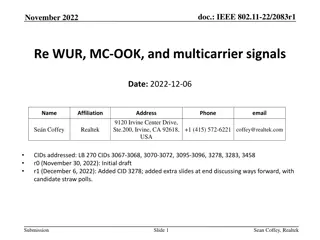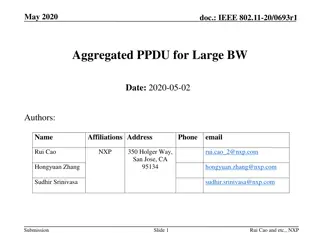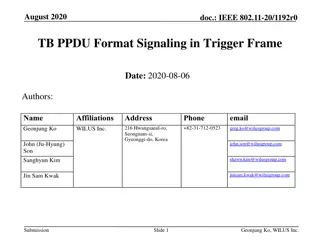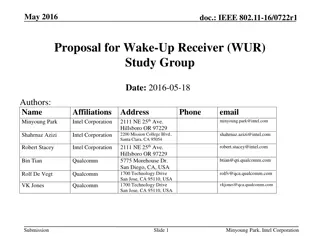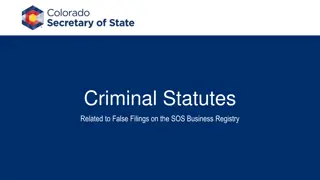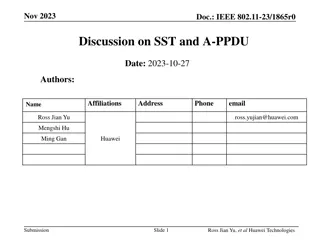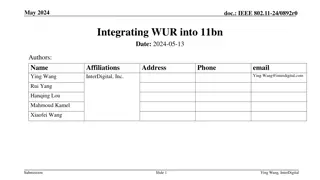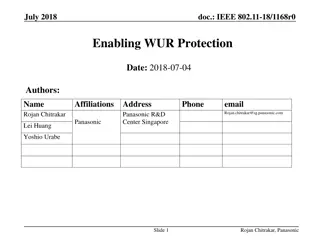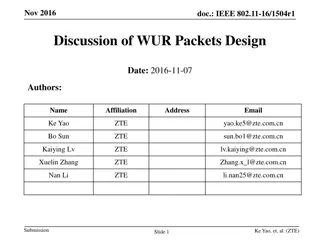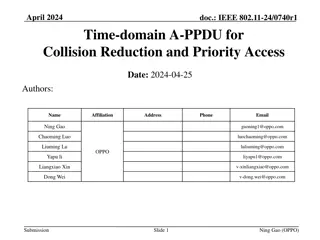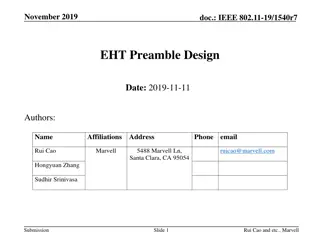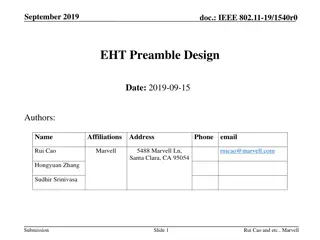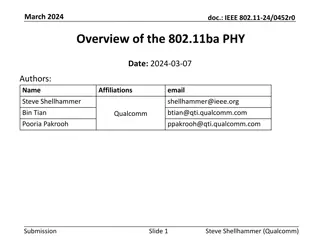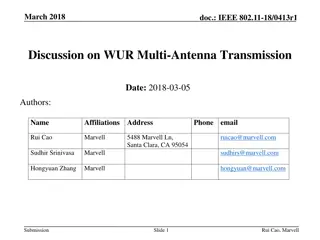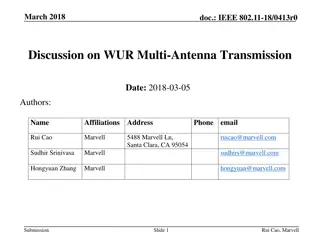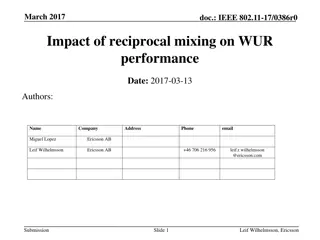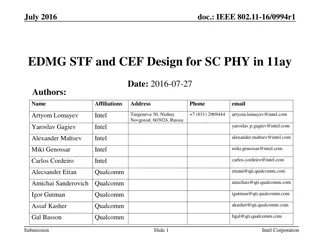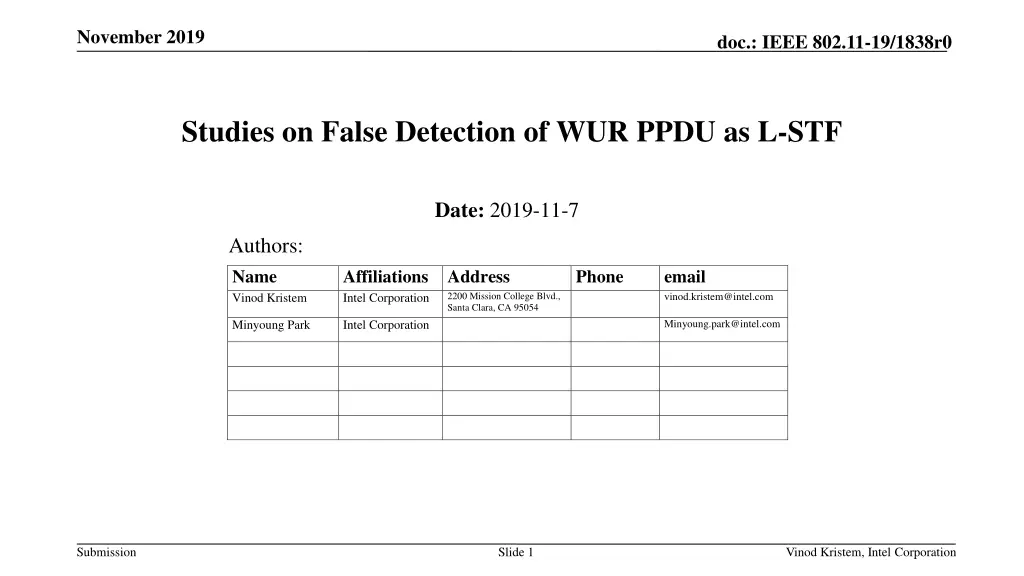
Studies on False Detection of WUR PPDU as L-STF
In this document from November 2019, the IEEE 802.11-19/1838r0 study focuses on the false detection of WUR (Wake-Up Radio) PPDU (Physical Protocol Data Unit) as L-STF (Legacy Short Training Field). The study introduces the Normalized Cross-correlation metric, explores cross-correlation values in different scenarios, and discusses the average cross-correlation values in AWGN (Additive White Gaussian Noise) with 20 dB SNR (Signal-to-Noise Ratio). Various examples and proposals are examined to address the detection challenges. The document provides insights into signal processing techniques and recommendations for improving detection accuracy.
Download Presentation

Please find below an Image/Link to download the presentation.
The content on the website is provided AS IS for your information and personal use only. It may not be sold, licensed, or shared on other websites without obtaining consent from the author. If you encounter any issues during the download, it is possible that the publisher has removed the file from their server.
You are allowed to download the files provided on this website for personal or commercial use, subject to the condition that they are used lawfully. All files are the property of their respective owners.
The content on the website is provided AS IS for your information and personal use only. It may not be sold, licensed, or shared on other websites without obtaining consent from the author.
E N D
Presentation Transcript
November 2019 doc.: IEEE 802.11-19/1838r0 Studies on False Detection of WUR PPDU as L-STF Date: 2019-11-7 Authors: Name Vinod Kristem Affiliations Address Intel Corporation Phone email vinod.kristem@intel.com Minyoung.park@intel.com 2200 Mission College Blvd., Santa Clara, CA 95054 Minyoung Park Intel Corporation Submission Slide 1 Vinod Kristem, Intel Corporation
November 2019 doc.: IEEE 802.11-19/1838r0 Introduction Normalized Cross-correlation metric: Defined as the cross-correlation between the WUR-packet and a delayed version of it, normalized by the energy Let x[n] be 20 MHz WUR baseband signal comprising of WUR preamble and WUR Data (? 1)? 1? ?+? ? ?+??+? | ?? 1? ?+? (1/ ? 1 )| ?=0 Metric 1: ?(?,?) = max (Steve s metric [11-19/1120]; also in D4.0) 2 (1/?) ?=0 ? T = 800 ns is the STS duration N is the number of STS sequences to accumulate L is the delay (measured in the number of STS sequences) Small L and Large N are better for averaging Used L = 1 and N = 6 for the studies Examined Example 1-3 in Annex AD in D4.0 and the proposal in [11-19/1120r0] (we ll call this as Example 4) Same transmit power in 20 MHz legacy + BPSK-Mark and 4 MHz WUR portion This is the worst case scenario of miss-detecting WUR packet as L-STF In PSD limited regulatory domains, WUR packet has smaller transmit power than L-STF and hence lower miss-detection Submission Slide 2 Vinod Kristem, Intel Corporation
November 2019 doc.: IEEE 802.11-19/1838r0 Cross-Correlation values in AWGN with 20 dB SNR Tx side (no noise) Legend 3 2 4 3 2 1 1 Dashed Baseband Tx signal Solid Baseband Rx signal Correlation test threshold in D4.0 Cross-correlation can be different across realizations due to symbol randomizer (random cyclic shifts) and random data At a high SNR, cross-correlation values are much lower than the L-STF value (0.98-1) LDR: Example 4 (Steve proposal [11-19/1120r0]) has the lowest correlation, but exceeds 0.4 Correlation threshold of 0.4 is not sufficient. The threshold should be increased to 0.65 Examples 2, 3, and 4 meet this requirement in almost all cases (80 percentile) HDR: All examples can exceed the correlation of 0.4 The threshold should be increased to 0.65. All three examples in Annex AD meet this requirement in almost all cases Submission Slide 3 Vinod Kristem, Intel Corporation
November 2019 doc.: IEEE 802.11-19/1838r0 Average Cross-Correlation values in AWGN with 20 dB SNR Metric 1 HDR Examples1 Metric 1 LDR Examples Example 1 0.52 Example 1 0.71 Example 2 0.45 Example 2 0.63 Example 3 0.58 Example 3 0.58 L-STF (reference) 0.99 Example 4 (Steve proposal [11-19/1120r0]) 0.53 L-STF (reference) 0.99 Table shows the average cross-correlation numbers, across different realizations (computed using Tx signal, i.e. no noise) LDR: All examples have much lower correlation than L-STF Examples 1 has the highest cross-correlation Example 4 (Steve proposal [11-19/1120r0]) has lowest correlation of 0.53 but still above 0.4 HDR: All examples have much lower correlation than L-STF Examples 1-3 have comparable correlation values between 0.45 and 0.58 Submission Slide 4 Vinod Kristem, Intel Corporation
November 2019 doc.: IEEE 802.11-19/1838r0 Cross-Correlation values in AWGN with 0 dB SNR 0 Only showing cross-correlation computed on received signal. Transmit signal same as in slide 3. At low SNR, cross-correlation values are already low, and most of the times lower than the L-STF value All LDR examples and HDR examples have similar cross-correlation (+/- 0.05) Submission Slide 5 Vinod Kristem, Intel Corporation
November 2019 doc.: IEEE 802.11-19/1838r0 Cross-Correlation values in AWGN with 0 dB SNR Metric 1 Metric 1 LDR Examples HDR Examples Example 1 0.49 Example 1 0.40 Example 2 0.50 Example 2 0.35 Example 3 0.46 Example 3 0.42 Example 4 (Steve proposal) 0.45 L-STF (reference) 0.50 L-STF (reference) 0.51 Table shows the average cross-correlation numbers, across different realizations (computed using Rx signal) At low SNR, cross-correlation values are already low LDR: All 4 examples have similar correlation values (0.45-0.50) HDR: All 3 examples have lower correlation than L-STF (0.35-0.42) Submission Slide 6 Vinod Kristem, Intel Corporation
November 2019 doc.: IEEE 802.11-19/1838r0 Cross-Correlation in Channel D with 20 dB SNR 4 Rx side (with noise+multipath) Tx side (no noise) Legend Dashed Baseband Tx signal Solid Baseband Rx signal In Channel D, the multipaths changes the effective shape of received waveform, thereby resulting in different cross-correlation value (than compared to the one measured on transmit signal). The cross-correlation can vary significantly across channel realizations, as can be seen above For instance, LDR Example 4 no longer provides lowest cross-correlation in 30% of realizations However, all examples have significantly lower cross-correlation compared to STF (close to 1) Submission Slide 7 Vinod Kristem, Intel Corporation
November 2019 doc.: IEEE 802.11-19/1838r0 Cross-Correlation in Channel D with 0 dB SNR Only showing cross-correlation computed on received signal. Transmit signal same as in slide 3. At low SNR, cross-correlation values are already low, and most of the times lower than the L-STF value All LDR examples and HDR examples have similar cross-correlation (+/- 0.05) Submission Slide 8 Vinod Kristem, Intel Corporation
November 2019 doc.: IEEE 802.11-19/1838r0 Cross-correlation in AWGN with multiple Tx antennas (LDR) Legend Dashed Baseband Tx signal Solid Baseband Rx signal L-STF L-STF L-STF Cross-correlation can be different for the signal transmitted from different antennas/RF chains, due to per-antenna CSD Since we are interested in worst case scenario, for each realization, we picked the max of cross-correlation across different antennas Receiver gets the combined signal from the Tx antennas. The geometrical LOS angle is modeled randomly across realizations. The cross-correlation with different examples is lower than L-STF Even with Example 4, the cross-correlation can go up to 0.65 (with 8 Tx antennas) Submission Slide 9 Vinod Kristem, Intel Corporation
November 2019 doc.: IEEE 802.11-19/1838r0 Cross-correlation in AWGN with multiple Tx antennas (HDR) Legend Dashed Baseband Tx signal Solid Baseband Rx signal Cross-correlation can be different for the signal transmitted from different antennas/RF chains, due to per-antenna CSD Since we are interested in worst case scenario, for each realization, we picked the max of cross-correlation across different antennas Receiver gets the combined signal from the Tx antennas. The geometrical LOS angle is modeled randomly across realizations. The cross-correlation with different examples is lower than L-STF All 3 examples exceed cross-correlation of 0.4. They are below 0.7 Submission Slide 10 Vinod Kristem, Intel Corporation
November 2019 doc.: IEEE 802.11-19/1838r0 Observation It seems to be a corner case for a legacy STA to start receiving a WUR PPDU from the WUR-Sync/WUR-Data field When a WUR PPDU is received at high SNR (i.e. 20 dB), all three on-waveform examples in the spec D4.0 showed much lower correlation values compared to the L-STF (see slide 4) It is a correct behavior for a legacy STA to defer it s transmission when a high-power WUR PPDU is detected because Transmitting on top of the strong WUR PPDU may cause collision Trying to receive another packet while the WUR PPDU is on the medium has little chance to succeed since the interference due to the WUR PPDU is already strong Even if another packet has much higher power than the WUR PPDU, this means the WUR PPDU transmitter, the legacy STA, and the STA that intends to transmit a PPDU to the legacy STA are all close to each other and therefore, there is high chance that the STA that intends to transmit to the legacy STA hears the WUR PPDU transmission and defers its transmission. Our simulation shows that Example 4 s correlation output at the Tx side (no noise, no channel) exceeds the correlation threshold 0.4 defined in D4.0 (see Slide 14 in the backup) When a WUR PPDU is received at low SNR (i.e. 0 dB), all three on-waveform examples in the spec showed low correlation outputs and was comparable to Example 4 [11-19/1120] on-waveform (ranging from 0.5 to 0.53 at 90%tile in slide 5) When a WUR PPDU is received over Channel D, an on-waveform that showed low correlation value in AWGN showed wide variation of the correlation outputs (0.45 to 0.75) above 0.4 When a WUR PPDU is transmitted using multiple antennas, the correlation output increases and exceeds 0.4 (Slides 9 and 10) Submission Slide 11 Vinod Kristem, Intel Corporation
November 2019 doc.: IEEE 802.11-19/1838r0 Conclusions A legacy STA detecting and deferring to a WUR PPDU received at a high SNR is a correct behavior When a WUR PPDU is received at low SNR, the correlation output at a legacy STA is already low for all three examples in 802.11ba D4.0 The correlation output at the receiver side exceeds the correlation threshold 0.4 defined in D4.0 when noise, multipath channel, and multiple antennas are taken into account The correlation test threshold 0.4 in D4.0 is too low We recommend to increase the correlation test threshold to 0.65 LDR: Example 3 and 4 meet the threshold 0.65 (Example 1 and 2 need to be replaced) HDR: Example 1, 2, and 3 meet the threshold 0.65 (no changes needed) Submission Slide 12 Vinod Kristem, Intel Corporation
November 2019 doc.: IEEE 802.11-19/1838r0 Straw Poll Do you agree to increase the correlation test threshold to 0.65? Y/N/A Submission Slide 13 Vinod Kristem, Intel Corporation
November 2019 doc.: IEEE 802.11-19/1838r0 Discussion on LDR Example 4 Figure shows example cross-correlation for the WUR-sync and WUR-Data portion of the packet, for transmit signal (1 Tx) WUR-preamble (or 2us pulse) is the bottleneck in cross-correlation number LDR Example 4 has cross-correlation of 0.28 when measured on WUR-Data portion, without applying symbol randomization The corresponding number increased to 0.43 with symbol randomization Submission Slide 14 Vinod Kristem, Intel Corporation



